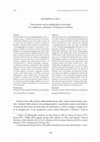Papers by Giuseppe La Bua
Deceptive oratory: Cicero in Sinon's speech (Verg. Aen. 2.57-198)
Classical Philology 120.1, pp. 104-117, 2025
This paper draws attention to Sinon’s speech in the second Book of the Aeneid as a specimen of de... more This paper draws attention to Sinon’s speech in the second Book of the Aeneid as a specimen of deceptive oratory, profoundly indebted to Cicero’s rhetorical and political manipulation of exilic topoi. It also points to the association of Sinon and Cicero as masters of dissimulatio in rhetorical theory in late antiquity. Although the comparison between Sinon and Cicero may have been originated in anti-Ciceronian propaganda, Vergil’s depiction of Sinon as a ‘Ciceronian’ orator suggests that Cicero’s manipulative exploitation of the psychagogic power of the logos impacted on his reception from the Augustan period onwards and contributed to the establishment of his figure as a ‘sophist’ in the educational system of late antiquity.

Silvas publicas depopulatus erat (Cic. Mil.26): natura ‘violata’, politica e invettiva nella strategia retorica ciceroniana
Ciceroniana online VII.2, 335-350, 2023
Ben lontana dalla moderna idea di ecologia, la difesa dell’habitat naturale in Cicerone costitui... more Ben lontana dalla moderna idea di ecologia, la difesa dell’habitat naturale in Cicerone costituisce una potente arma di lotta politica e invettiva nelle orazioni giudiziarie. La violazione della natura, la cui distruzione rappresenta un pericolo per la stabilità della societas, è letta – e manipolata - dal Cicerone politico come attacco contro la res publica e, al medesimo tempo, come atto di sacrilegio e hybris, punito dalla divinità garante dell’ordine naturale. Il presente lavoro mira a rileggere il rapporto uomo-natura nella strategia retorico-politica ciceroniana e osserva le modalità attraverso le quali l’Arpinate sfrutta il motivo della natura violata come strumento di demolizione dell’auctoritas morale dell’avversario.
Teaching Cicero through the scholia, in Dennis Pausch and Christoph Pieper (eds.), The Scholia on Cicero’s Speeches. Contexts and Perspectives, Leiden/Boston, Brill, 2023, 22-40
Dal ‘vero’ al ‘falso’ Catilina: retorica e politica nei pseudepigrapha ciceroniani
in A. Comboni and S. La Barbera (eds.), Le vie del falso, Bologna, Il Mulino, 2023, 77-94, 2023

Intertextuality, parody, and immortality of poetry: Petronius and Ovid
in J. Farrell-D. Nelis-A. Schiesaro-J. Miller (eds.), Ovid, Death and Transfiguration, Leiden/Boston, Brill, 2023, 351-66, 2023
Immortality of poetry is crucial to Ovid’s self-fashioning as a canonical love elegist. In the ep... more Immortality of poetry is crucial to Ovid’s self-fashioning as a canonical love elegist. In the epilogue to the Metamorphoses (15.871-9) Ovid celebrates his apotheosis as a poet and predicts his transformation into a textual body. Poetic memory and the art of allusion participate in this process of transfiguration of Ovid into an elegiac voice. By intertextuality Ovid’s love poems show their perennial, latent vitality. In alluding to or reusing Ovid’s language and themes the reader-imitator transforms his model into a new elegiac text. This artistic process of literary ‘metamorphosis’ becomes much more evident in parody, comic intertextuality, that recreates – and revitalizes - the distorted model in paradoxical forms. This paper re-examines a limpid case of parody of Ovid’s amatory works in Petronius’ Satyrica. It focuses on the evocation of Ovid’s elegiac texts in the love-story between Circe and Encolpius/Polienus and, in particular, on the comic manipulation of the Heroides in the epistolary exchange between the two lovers (Petr. 129-30). It tries to demonstrate that parody, as a form of literary recreation (though in humorous fashion), actively contributes to the transfiguration of Ovid into the exemplar par excellence of love elegy.

Sen. Dial. 11.9.4-8: Marcello, il felix exul di Seneca e la reprehensio Ciceronis nella prima età imperiale,
Athenaeum 110, 1, pp. 92-111, 2022
Seneca’s depiction of Marcellus as the paradigm of virtuous exile in the Consolation to his mothe... more Seneca’s depiction of Marcellus as the paradigm of virtuous exile in the Consolation to his mother Helvia (Dial. 11.9.4-8) is intended to be a celebration of the Stoic ideal of political freedom, embodied in the legendary figure of Cato of Utica, the heroic opponent to tyrannical power. Strikingly enough, in this passage the philosopher says nothing of Cicero’s role in Marcellus’ recall from exile. This paper re-examines the passage of the Consolation and interprets it as a significant testimony to the anti-Ciceronian tradition in the early imperial age. Specifically, it elaborates on Cicero’s self-portrait as an ‘unwise man’, distressed by the dramatic and inhuman experience of exile, and considers Cicero’s refusal of philosophical consolation as a major step forward in the representation of the republican orator as the antithesis to sapientia, an image reiterated and transmitted by the rhetorical-historical tradition and Seneca’s philosophical thought. It also suggests that, in deliberately leaving out Cicero’s name in the so-called ‘Marcellus-issue’, Seneca takes a polemical stance over the ineffectual power of Ciceronian non-Stoic oratory.

Il linguaggio della satira nell'epistolario pliniano
Paideia LXXVII, 2022
Starting from Pliny the Younger’s self-portrait as a neoteric and epigrammatic poet, this paper d... more Starting from Pliny the Younger’s self-portrait as a neoteric and epigrammatic poet, this paper discusses the use of satiric themes and language in the epistolary corpus. It focuses on the Plinian practice of indignatio as constantly related to the nostalgic re-evocation of an idealized, aristocratic past. Without resembling the tones of Juvenal’s satirical invective, Pliny deploys satiric topics and language to censure the modern mores, seen as a potential threat to the aristocratic notion of Romanitas. As both a good observer and judge of his own age, he denounces the contemporary distortions and deviations from the values shared by the members of the early empire aristocratic society. In doing so, Pliny recalls the satirical character of Martial’s poetry and depicts himself as a public engaged figure, concerned with the preservation of the true, authentic Roman mores.
Cicerone e l'educazione nel mondo tardoantico
This paper examines the influence exerted by Cicero as orator on the Roman educational system fro... more This paper examines the influence exerted by Cicero as orator on the Roman educational system from the Late Republic to the Early Middle Ages

Man of Peace? Cicero's Last Fight for the Republic in Greek and Roman Historical 'Fictions
Cicero’s involvement in the political crisis of the Late Republic elicited divergent reactions fr... more Cicero’s involvement in the political crisis of the Late Republic elicited divergent reactions from historians, declaimers and men of letters in the early imperial period. In particular, Cicero’s controversial role in the outbreak of the civil war of 49-45 BCE ignited a fierce debate over his political legacy and the role he played in the violent transition from the Republic to the imperial regime. This chapter starts from the depiction of Cicero as ‘man of war’ in Lucan’s epic-historical fiction and draws attention to the ambivalent treatment of Cicero as politician in Greek and Roman historical accounts. It then focuses on Cassius Dio’s reconfiguration of Cicero as moral and political authority in the speech on amnesty. By fictionalizing Cicero as a man torn between love of peace and political harmony on the one hand and desire for personal glory on the other, historians of the early empire elaborated on the relevance of the ideals of concord and stability to the downfall of Repub...
Dictynna, 2018
Questo documento è stato generato automaticamente il 10 settembre 2020. Les contenus des la revue... more Questo documento è stato generato automaticamente il 10 settembre 2020. Les contenus des la revue Dictynna sont mis à disposition selon les termes de la Licence Creative Commons Attribution-Pas d'Utilisation Commerciale-Pas de Modification 4.0 International.

Cicero's Pro Milone and the ‘Demosthenic’ Style: De Optimo Genere Oratorum 10
Greece and Rome, 2014
In a passage from the late rhetorical treatise generally known as De optimo genere oratorum, Cice... more In a passage from the late rhetorical treatise generally known as De optimo genere oratorum, Cicero defends his past forensic competence in the face of Atticist critique by praising his Pro Milone as an example of grand style (9–10):quod qui ita faciet, ut, si cupiat uberior esse, non possit, habeatur sane orator, sed de minoribus; magno autem oratori etiam illo modo saepe dicendum est in tali genere causarum. (10) ita fit ut Demosthenes certe possit summisse dicere, elate Lysias fortasse non possit. sed si eodem modo putant, exercitu in foro et in omnibus templis, quae circum forum sunt, conlocato, dici pro Milone decuisse, ut si de re privata ad unum iudicem diceremus, vim eloquentiae sua facultate, non rei natura metiuntur.If anyone speaks in this manner without being able to use a fuller style if he wishes, he should be regarded as an orator, but a minor one. The great orator must often speak in that way in dealing with cases of such a kind. (10) In other words, Demosthenes coul...

The Classical Quarterly, 2013
Shortly after his accidental transformation into an ass, Lucius attempts to return to his human f... more Shortly after his accidental transformation into an ass, Lucius attempts to return to his human form by grabbing some roses decorating a statue of the patron goddess of the quadrupeds, Epona. But his servulus feels outraged at the sacrilegious act. Jumping to his feet in a temper and acting as a faithful defender of the sacred place, he addresses his former human owner as a new ‘Catiline’ (Apul. Met. 3.27): Quod me pessima scilicet sorte conantem servulus meus, cui semper equi cura mandata fuerat, repente conspiciens indignatus exurgit et: ‘quo usque tandem’ inquit ‘cantherium patiemur istum paulo ante cibariis iumentorum, nunc etiam simulacris deorum infestum? Quin iam ego istum sacrilegum debilem claudumque reddam.’My attempt was frustrated by what seemed to be the worst of luck: my own dear servant, who always had the task of looking after my horse, suddenly saw what was going on, and jumped up in a rage. ‘For how long’, he cried, ‘are we to endure this clapped-out beast? A minut...

Partendo dalla nozione di pseudepigraphon come 'riscrittura creativa', risultato di un processo d... more Partendo dalla nozione di pseudepigraphon come 'riscrittura creativa', risultato di un processo di ricezione/ emulazione/competizione che sfocia nella creazione di un nuovo testo (che ambisce a sostituire o integrare il modello), il presente lavoro prende in considerazione i pseudepigrapha ciceroniani, in particolare la Responsio Catilinae, un'invettiva in replica alla Quinta Catilinaria (entrambe prosopopoeiae nate nelle scuole di retorica, presumibilmente databili all'XI-XII secolo). Dopo un sintetico sguardo ai falsi ciceroniani, l'articolo esamina la struttura retorica, contenuto e linguaggio di entrambi i testi, che ricreano il contrasto dialettico fra Cicerone e Catilina nella seduta senatoriale del 7 o 8 novembre del 63 a.C. (Prima Catilinaria). La Responsio funge da necessario supplemento nella biografia politica di Cicerone: colma una lacuna nella tradizione catilinaria, l'assenza della voce di Catilina nel dibattito sulla congiura. L'invettiva, in aggiunta, rivendica il ruolo morale dell'oratoria, ars fondata sui principi dell'aequitas, e ritrae Catilina come vir bonus dicendi peritus. In questa chiave di lettura, la Responsio spiana il terreno per quel fenomeno politico-letterario di rivalutazione del personaggio Catilina che troverà sbocco nel cosiddetto 'Catilinarismo' di età umanistica e rinascimentale.
Portraying Cicero in Literature, Culture, and Politics, 2022
Homo novus and nobilis:C iceroa nd the formation of the 'modern' aristocracy 1I ntroduction Cicer... more Homo novus and nobilis:C iceroa nd the formation of the 'modern' aristocracy 1I ntroduction Cicero's novitas, "newness",iswellknown to have had asignificant influenceon OpenAccess.
The Poet as a Forger
Tenue est mendacium, 2022

Osservazioni sui pseudepigrapha ciceroniani e la ‘tradizione catilinaria’: la Responsio Catilinae, “Incontri di Filologia Classica” XX (2020-2021), 299-324, 2020
Partendo dalla nozione di pseudepigraphon come 'riscrittura creativa', risultato di un processo d... more Partendo dalla nozione di pseudepigraphon come 'riscrittura creativa', risultato di un processo di ricezione/ emulazione/competizione che sfocia nella creazione di un nuovo testo (che ambisce a sostituire o integrare il modello), il presente lavoro prende in considerazione i pseudepigrapha ciceroniani, in particolare la Responsio Catilinae, un'invettiva in replica alla Quinta Catilinaria (entrambe prosopopoeiae nate nelle scuole di retorica, presumibilmente databili all'XI-XII secolo). Dopo un sintetico sguardo ai falsi ciceroniani, l'articolo esamina la struttura retorica, contenuto e linguaggio di entrambi i testi, che ricreano il contrasto dialettico fra Cicerone e Catilina nella seduta senatoriale del 7 o 8 novembre del 63 a.C. (Prima Catilinaria). La Responsio funge da necessario supplemento nella biografia politica di Cicerone: colma una lacuna nella tradizione catilinaria, l'assenza della voce di Catilina nel dibattito sulla congiura. L'invettiva, in aggiunta, rivendica il ruolo morale dell'oratoria, ars fondata sui principi dell'aequitas, e ritrae Catilina come vir bonus dicendi peritus. In questa chiave di lettura, la Responsio spiana il terreno per quel fenomeno politico-letterario di rivalutazione del personaggio Catilina che troverà sbocco nel cosiddetto 'Catilinarismo' di età umanistica e rinascimentale.
Sulla pseudo-ciceroniana "Si eum P. Clodius legibus interrogasset" e sull'ordine delle orazioni negli "Scholia Bobiensia
Rivista di Filologia e di Istruzione Classica, 2001

Ciceroniana on line, 2015
La pubblicazione nel1926 dello studio di Johannes Stroux, che prende il titolo dalla massima cice... more La pubblicazione nel1926 dello studio di Johannes Stroux, che prende il titolo dalla massima ciceroniana citata nel De officiis l, 33 (summum ius summa iniuria)(l), ha dato il via ad un'ampia diatriba circa il ruolo e l'importanza del sistema retorico greco per lo sviluppo della scienza giuridica romana. L'ipotesi di Stroux di un rinnovamento del diritto romano, caratterizzato nei secoli della Repubblica da continui mutamenti e da processi 'in divenire', ad opera di una teoria retorica greca sull' interpretatio legis, esemplificata nella dottrina degli status (2), ha incontrato entusiasti pareri (3) e forti critiche(4) ma, al di là delle diverse opinioni che è non qui il caso di indagare, uno dei grandi meriti che credo possano essere attribuiti allo scritto 'rivoluzionario' di Stroux è quello di aver aperto la strada ad un'indagine più approfondita relativamente agli stretti legami che intercorrono tra scienza giuridica e retorica: in tal senso l'utilità di un'analisi che sappia tener conto in maniera adeguata dell'influenza esercitata dalla retorica sui metodi d'interpretazione dei giuristi romani è evidente nello studio di R. A. Bauman(5), il quale ha mostrato come l'interpretazione di alcuni casi (l) Summum ius summa iniuria. Ein Kapitel aus der Geschichte der interpretatio iuris, Leipzig-Berlin 1926 (=Id., Romische Rechtswissenschaft und Rhetorik, Potsdam 1949, 9-66). (2) La sistemazione della dottrina degli status, in abbozzo già in Aristotele e nella speculazione legata all'ambiente peripatetico-accademico, è attribuita ad Ermagora di Temno; cfr. a questo proposito L.
Medicina consularis: Cicerone e la cura dello stato
Nihil infinitum est nisi oceanus" (Sen. Suas. 1,1): Il mare nelle declamazioni latine
Maia-rivista Di Letterature Classiche, 2015











Uploads
Papers by Giuseppe La Bua